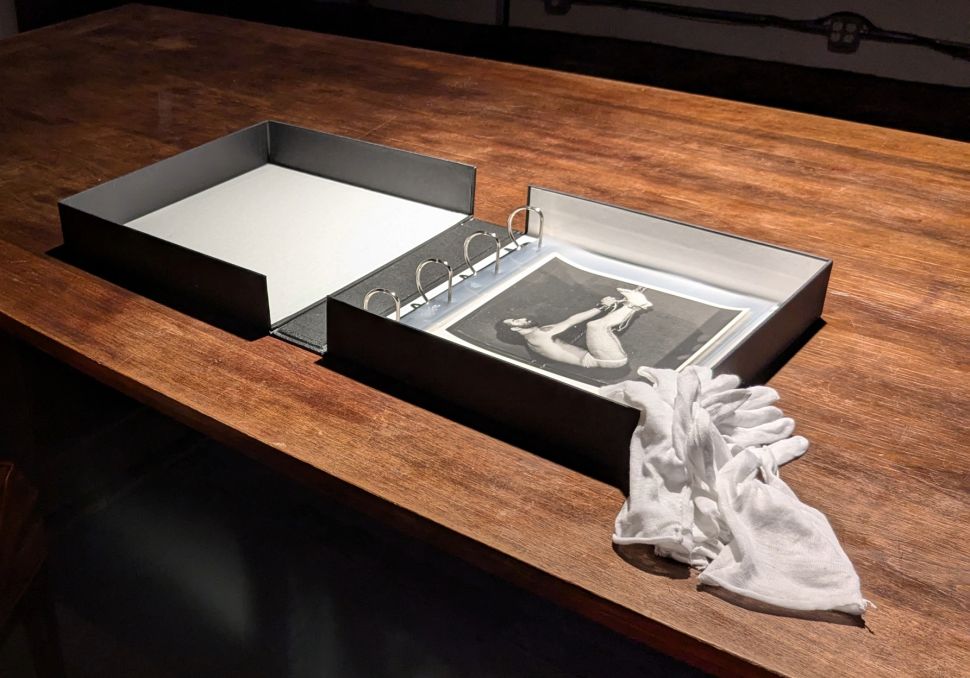In a radical collision of high art and leather-bound taboo, a cache of never-before-seen Robert Mapplethorpe S&M photographs has surfaced in New York City, bringing with it all the swagger and controversy that defined the photographer’s boundary-shattering legacy. Made public for the first time by the Kinsey Institute, the trove of test prints offers a rare opportunity to commune with Mapplethorpe’s unfiltered vision.
In private hands for nearly half a century, the portfolio was recently purchased by Kinsey, a venerable temple of carnal knowledge tucked away at Indiana University that is also the steward of an important collection of Mapplethorpe photography. Originally gifted by the photographer to subjects Dominick and Elliot in 1979, the portfolio features eleven unfinished outtakes from the same transgressive session that yielded Mapplethorpe’s famous image of the couple. These aren’t polished gallery pieces: they’re raw artistic experiments that shed new light on the legendary photographer’s artistic process.
SEE ALSO: Don’t Miss Fa Razavi’s Defiant Debut at Palo Gallery
“In stark contrast to Mapplethorpe’s finished prints, these are raw,” Rebecca Fasman, curator at the Kinsey Institute, told Observer. “They’re not printed to his standards, what we as viewers are used to seeing when we think of Mapplethorpe’s work. This allows us to see a bit more into the journey between what was happening in front of the camera and what the finished work looks like.”
The photos were recently displayed to an invited group of “artists, scholars, curators, journalists, leather enthusiasts” and others in an appropriately spare and dark room on the second floor of 222 Bowery, a little-improved 19th-century walk-up with an outsized artistic history of its own. The site of New York City’s first YMCA, the building was home to a thriving art commune and counted art world luminaries Fernand Léger, Mark Rothko, Roy Lichtenstein and William S. Burroughs as residents over the years.
The well-known centerpiece photograph of the portfolio captures Elliot standing coolly, cigarette in one hand, grasping Dominick’s testicles with the other. Dominick hangs upside down, completely nude, suspended by his ankles, his arms outstretched in a posture that deliberately subverts the religious iconography of crucifixion with sadomasochistic ritual.
But this portfolio of outtakes reveals a much more complex narrative than the singular iconic shot. There’s Dominick bound at the wrists and ankles suspended by chains. There’s Elliot sitting on Dominick’s face. There’s Dominick glancing wistfully upward at Elliot, who is caressing the submissive Elliot’s throat. The stark black-and-white compositions do what Mapplethorpe did best: transform the socially unacceptable into formalist art through meticulous attention to light, shadow and balance.
S&M aesthetics have long flowed from art’s underground tributaries into mainstream consciousness. Surrealist Man Ray flirted with bondage imagery in the early 1930s. Japanese photographer Nobuyoshi Araki is known globally for his images of rope-bound subjects. Contemporary artists Catherine Opie further expanded this visual language, reclaiming S&M imagery through feminist and queer perspectives.
What distinguishes Mapplethorpe’s approach is his classical formalism—these aren’t just documents of a sexual subculture but carefully constructed compositions that borrow from classical sculpture and Renaissance portraiture. The Dominick and Elliot photographs reveal his obsession with symmetry, his deep understanding of chiaroscuro and his ability to find geometric perfection in human flesh.
Mapplethorpe’s career, cut short by AIDS in 1989 at age 42, was also defined by his ability to blur the boundaries between pornography and fine art. His clinical yet intimate approach to documenting the gay S&M subculture of 1970s New York established him as both a celebrated artist and cultural provocateur.
The ghost of “The Perfect Moment”—Mapplethorpe’s posthumous exhibition that sparked a national firestorm in 1990—still haunts American art discourse. When the Corcoran Gallery canceled the show, and Cincinnati’s Contemporary Arts Center director Dennis Barrie faced obscenity charges for displaying Mapplethorpe’s work, the art world found itself in an unprecedented legal battle. Barrie’s eventual acquittal represented a watershed moment for artistic freedom, establishing that even explicit sexual imagery could be constitutionally protected when it possessed serious artistic merit.
“‘The Perfect Moment’ controversy was so consequential to museums,” Fasman said. “It was the first time that a museum director was charged with obscenity for the work hung in the museum. And now, in our current climate, we do see state and federal bills attempting to push criminal charges on culture workers. The U.S. is in this how-are-we-defining-obscenity and what-is-the-government’s-role-in-funding-art ongoing existential crisis.”
Fasman added that the response to the private showings of the new works was overwhelmingly positive and that she expects the institute will make them more widely available. “I would love to exhibit this portfolio, either as the entire focus of a show or as part of something larger, perhaps looking at Mapplethorpe’s test prints as an instructive framework to think about the final products he created.”
As censorship battles rage anew in contemporary America, Mapplethorpe’s unflinching gaze feels prescient rather than historical. These newly surfaced prints remind us that art’s highest calling is to illuminate society’s shadows—not to sanitize human desire but to frame it in ways that force contemplation of what we celebrate, what we fear and why the distinction matters at all.

